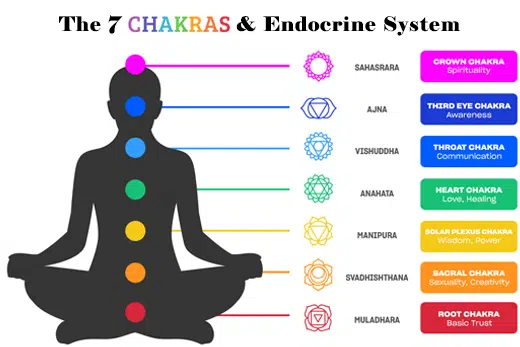Shad Chakras & Endocrine System – Relevance In Maintaining Health And Managing Diseases
Abstract
The concept of chakras was initially intended towards the spiritual aspect. However, western systems were known to use chakras for nutritional treatments. Various scientific studies today show a strong connection between the body’s working mechanisms and the chakras. Chakras are known to contain cosmic energy and are called energy centers of the body. Supporting this ideology, evidence came to light that chakras might produce electromagnetic radiation. There are a total of 6 chakras in the body which are physically connected to the body’s primary nerve plexus and physiologically to the endocrine glands.

Introduction
The word chakra denotes to ‘wheel’ or ‘circle.’ Ancient practices of yoga, mudras, mantras, breathing techniques focused on controlling the flow of cosmic energy through chakras. According to Indian beliefs, human life exists simultaneously through two parallel dimensions; Physical (Sthoola) and Non-physical (Sukshma).The physical body is denoted as mass and non-physical body is cosmic energy. The body and mind interact and mutually affect each other through these dimensions. The non- physical body comprises energy channels (Nadi) connected by chakras.
Shad Chakras – The chakras are 6 in number. There is also a seventh chakra which is placed above the line of the body, a few inches above the head crown. This chakra is activated only when all the 6 chakras below are themselves active and aligned. The first chakra starts at the base of the spine without which no other chakras can function, compelling the interpretation that every problem is solved at the root.
Endocrine System – There are a group of organs called glands that make the endocrine system. These glands are found all over the body producing and secreting various hormones like estrogen by ovaries in (women), melatonin by pineal gland etc.
Shad Chakras and Endocrine System – It is quite fascinating to see a link between the cosmic chakras and endocrine system of the body. If we consider the location of chakras and endocrine glands in the body, it can be derived that chakras might be controlling the endocrine glands in that area through Vata Dosha.
1. Muladhara Chakra (Root Chakra)
It is located at the base of the spine.
- Associated regions – Perineum, 1-3 base vertebrae pelvic plexus.
- Characteristics – Red color
- Element – Earth
- Endocrine Relation – There are no endocrine glands present in this area. However, the working of the chakra can be related to adrenal glands. The adrenal gland produces adrenaline which has a fight or flight response. This is also an important feature of the Muladhar Chakra.
- The pelvic plexus controls the visceral tissue for the eliminative and sexual function of the root chakra.
- The first 3 base vertebrae are essential for foundation and support.
- Imbalanced Chakra – Weight gain, frustration, lack of purpose, insecurity.
- Balanced Chakra – Due to its location, it helps in the treatment of diseases like infertility, abnormalities of the genital organs, etc. Proper secretion of adrenal hormones will lead to an energetic, confident, strong and balanced self. Healthy cortisol levels will regulate blood pressure and stress response.
- How to Balance?
- Advice to open a blocked root chakra involves making a connection with earth through physical activities like trekking, walking on grass, gardening etc.
- Chanting of Beej Mantra ‘Lam.’
- Yoga Poses – Vrikshasana (Tree Pose), Tadasana (Mountain Pose).
2. Swadhisthana Chakra (Sacral Chakra)
It is located in the pelvic area just below the navel right above the root chakra.
- Associated regions – Kidney, bladder, reproductive system, genitals.
- Characteristics – Orange color
- Element – Water
- Endocrine Relation – This chakra is closely related to adrenal glands, testicles or ovaries. It generates sex hormones like testosterone, estrogen etc. These hormones greatly affect our stress levels, mood, decision-making, sexual and mental life.
- Imbalanced Chakra – Leads to genital issues like vaginal discharge, menstrual irregularities, irritability, lack of energy, PCOD, etc.
- Balanced Chakra – Balance of hormones, feeling of vibrancy and happiness, good quality ovum, improved sex drive.
- How to Balance?
- Chanting of Beej Mantra ‘Vam.’
- Yoga Poses – Kakasana (Crow Pose), Trikonasana (Triangle Pose).
3. Manipura Chakra (Solar Plexus)
It is located between the navel and solar plexus
- Associated region – Digestive system, pancreas, liver, lungs and stomach.
- Characteristics – Yellow color
- Element – Fire
- Endocrine Relation – This chakra is largely associated with the digestive system, especially pancreas. The gut is considered as the second brain due to numerous neurons and communication with the brain. Pancreas is responsible for generating digestive enzymes.
- This chakra affects mental function because problems in the gut directly affect brain function.
- It is the storehouse of Prana (Life Energy).
- Imbalanced Chakra – Results in poor digestion, altered blood pressure, diabetes, fatigue, depression, OCD etc.
- Balanced Chakra – More energy, confidence, focus and productivity.
- How to Balance?
- Chanting of Beej Mantra ‘Ram.’
- Yoga Poses – Paschimottanasana (Forward Bend Pose), Dhanurasana (Bow Pose), Bhujangasana (Cobra Pose).
4. Anahata Chakra (Heart Chakra)
It is located in the center of the chest at heart level.
- Associated region – Heart, circulatory system, lungs.
- Characteristics – Green color
- Element – Air
- Endocrine Relation – This chakra is associated with the thymus gland. It functions as an immunity gland. It is responsible for the production of T-cells. Physically, it is responsible for the circulation of blood as it controls the lungs and heart.
- Imbalanced Chakra – Immunodeficiency, emotional problems such as anger, trust, jealousy, moodiness.
- Balanced Chakra – Strong immune system, strengthening of bones and muscles, feelings of compassion, care, optimism and motivation.
- How to Balance?
- Chanting of Beej Mantra ‘Yam.’
- Yoga Poses – Matsyasana (Fish Pose), Ardha setu bandhasana (Half Bridge Pose).
5. Vishuddha Chakra (Throat Chakra)
It is located at the base of the throat, neck and shoulder region.
- Associated region – Thyroid, esophagus, upper vertebrae.
- Characteristics – Blue color
- Element – Space
- Endocrine Relation – This chakra is correlated with thyroid and parathyroid glands. It secretes hormones, regulates metabolism, heartbeat, brain development and bone health.
- Fear, stress and anxiety can affect the throat chakra causing thyroid problems.
- Imbalanced Chakra – Weakness due to altered thyroid levels, being quiet and unable to express one’s self, weight gain or loss.
- Balanced Chakra – Full of energy and creativity, positive self-expression, good communication.
- How to Balance?
- Chanting of Beej Mantra ‘Ham’
- Yoga Poses – Halasana (Plough Pose), Sarvangasana (Shoulder Stand Pose).
6. Ajna Chakra (Third Eye Chakra)
It is located between the eyebrows on the forehead.
- Associated region – Pituitary gland, eyes, brain, ears, Pineal gland
- Characteristics – Indigo
- Element – It is not associated with any element.
- Endocrine Relation – This chakra is said to be linked with the pituitary gland. It is called the master gland as it controls the working of other glands.
- The third eye has both physical and metaphysical implications. Eyes help translate physical images into signals that can be mentally processed.
- Imbalanced Chakra – Headaches, blurry vision, Eye strain, Epilepsy, issues processing stimulus and emotions.
- Balanced Chakra – Strengthening of nervous system, fear of death subsides, liberation from materialistic world.
- How to Balance?
- Chanting of Beej Mantra ‘Om’
- Yoga Poses – Shirshasana (Headstand)
- Ajna chakra is best balanced through meditation and Pranayama (Brahmari technique-Humming Bee Breath).
7. Sahasrara Chakra (Crown Chakra)
It is located above the crown of the head. It is the site of dispersion of divine energy into the soul bringing spiritual liberation and enlightenment.
- Associated region – Pineal gland, nervous system
- Characteristics – Violet and White color
- Element – There is no element associated with it.
- Endocrine Relation – It is correlated with the pineal gland. This gland is responsible for sleep and wake cycles, bodily functions and awareness.
- It is the connection between the physical self and the spiritual world.
- Enlightenment, bliss and divine love are all associated with this chakra.
- This chakra is said to be dormant and is activated only after the alignment of all the other 6 chakras.
- Imbalanced Chakra – Insomnia, constant feelings of frustration and destruction.
- Balanced Chakra – Crystal clear perspective on the world, attaining inner peace.
- How to Balance?
- Chanting of Beej Mantra ‘Aum’
- Yoga Poses – Shirshasana (Headstand)
How to Balance All the Chakras?
Just one practice won’t help attain balance in these cosmic entities. One has to align one’s own life in order to align the chakras:
- Food – This is one of the most important tools to bring about a balance in the body.
- Pranayama – This practice will restore the natural flow of ‘prana’ in the body.
- Yoga – It is a direct way to stimulate the chakras, increase blood flow thus promoting healing in the body.
- Meditation – Non-physical way to focus the energy of the chakras and help restore the power of the mind.
- Mudras – It is an amazing way to level up the practice of yoga and meditation, bringing a whole new meaning to the routine.
Conclusion
Understanding the chakras is one of the best ways to access different levels of unconsciousness. One dimension of chakras is spiritual and other is physical and physiological. Chakras are the map of your inner world and knowledge of the endocrine system helps you to see it in a clear way. Understanding them is an unconventional method of listening to the problems of the body and mind and curing them. A disease free existence is possible through meditation and chakra aligning.



